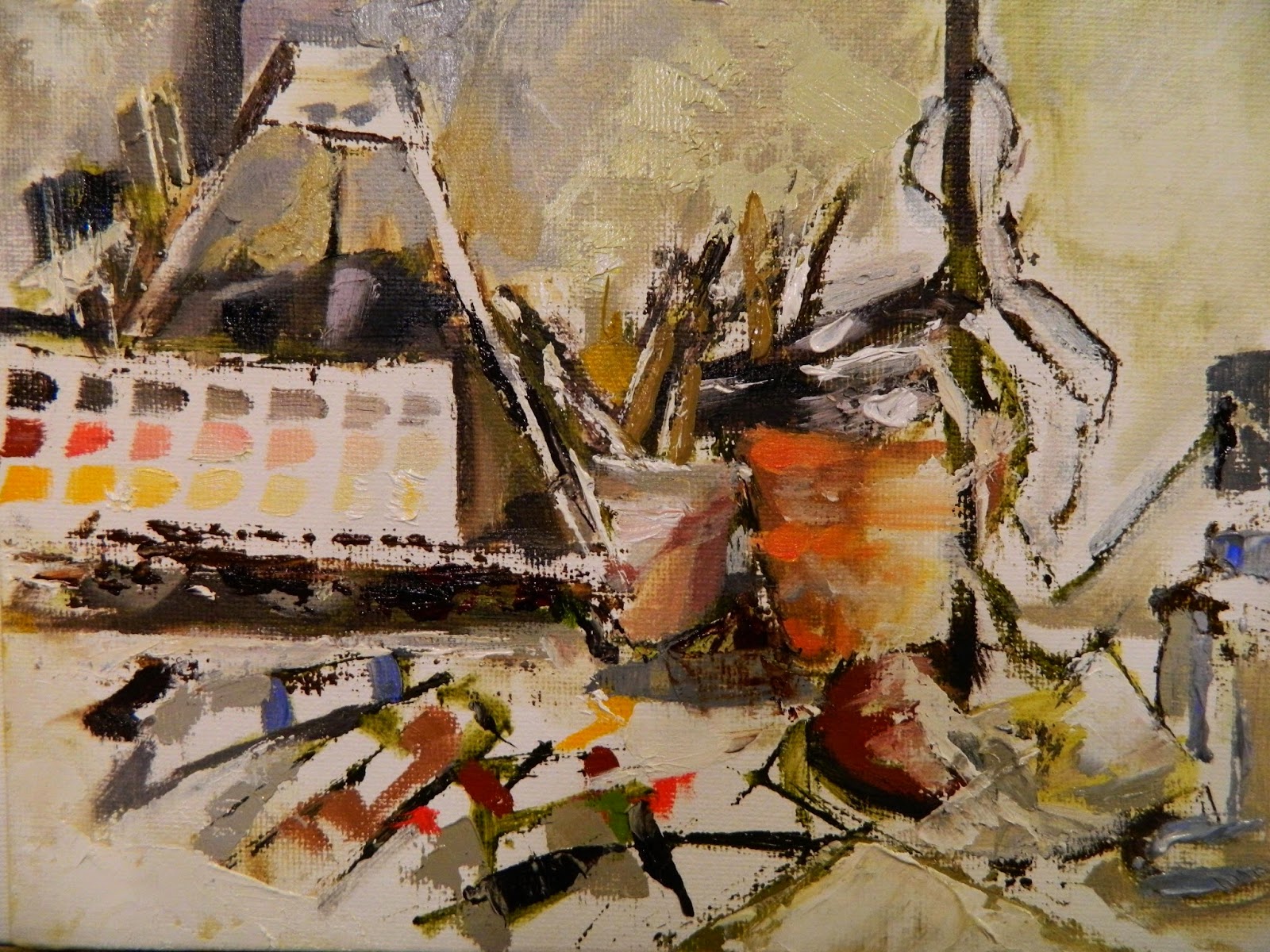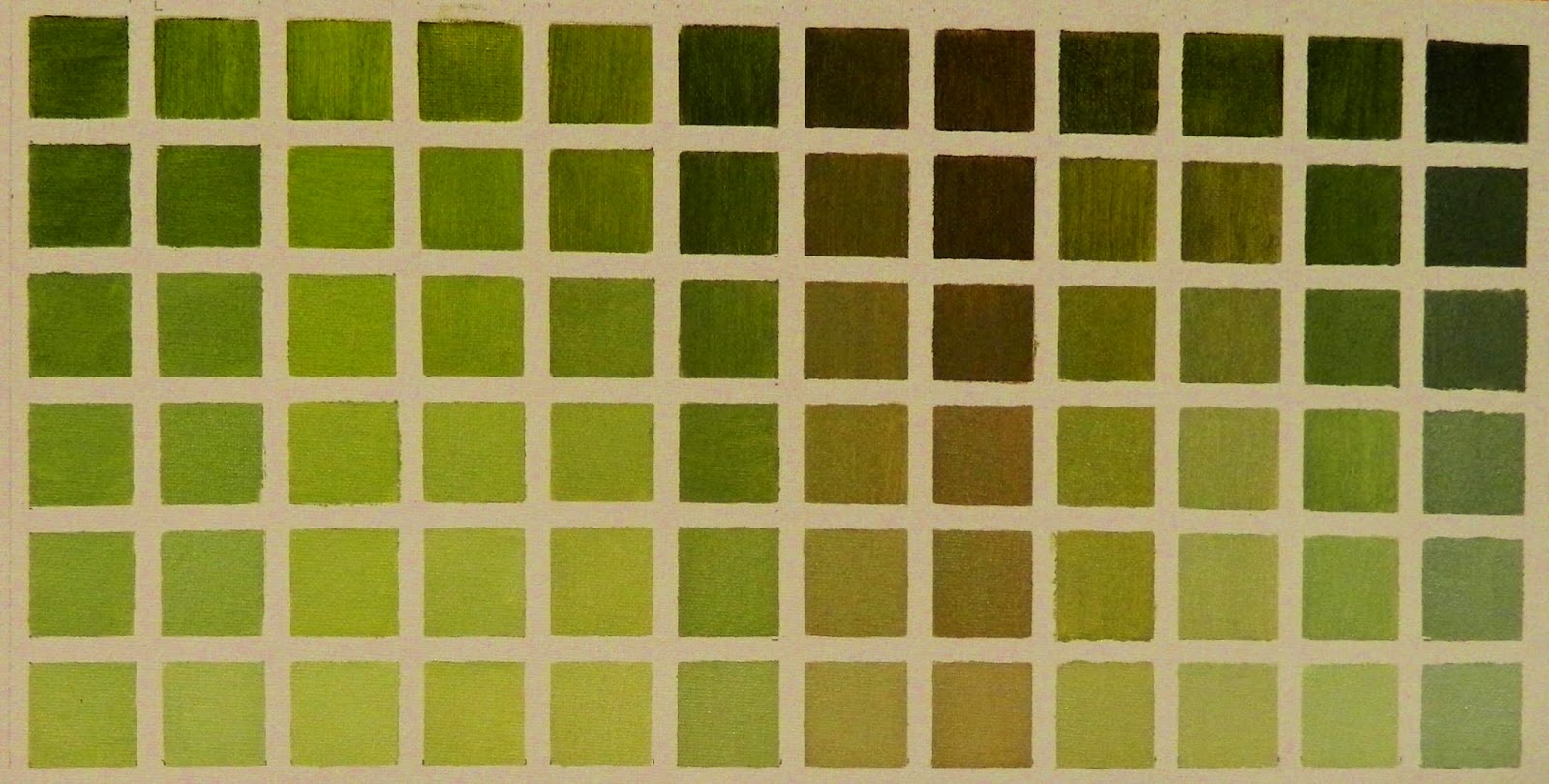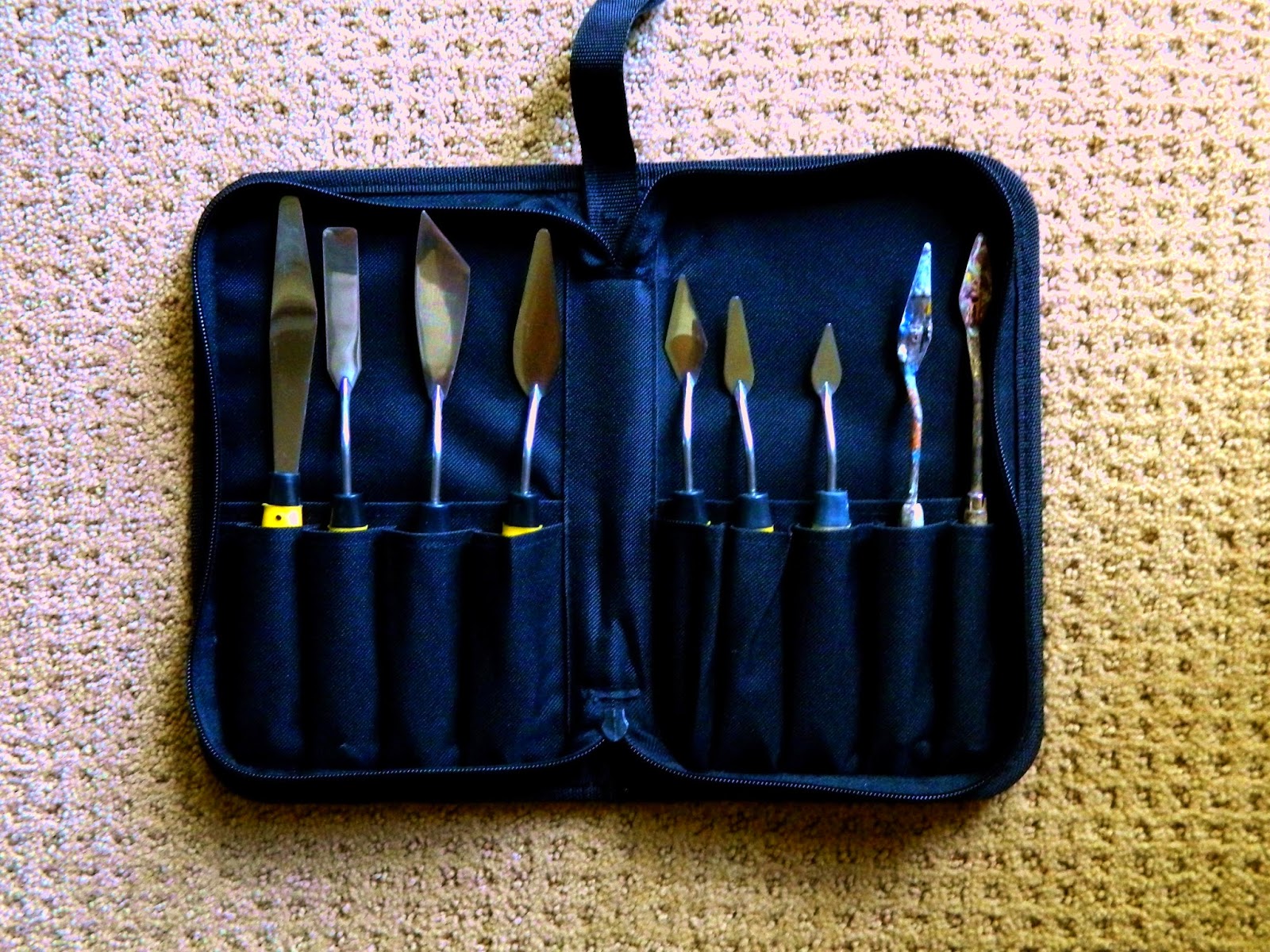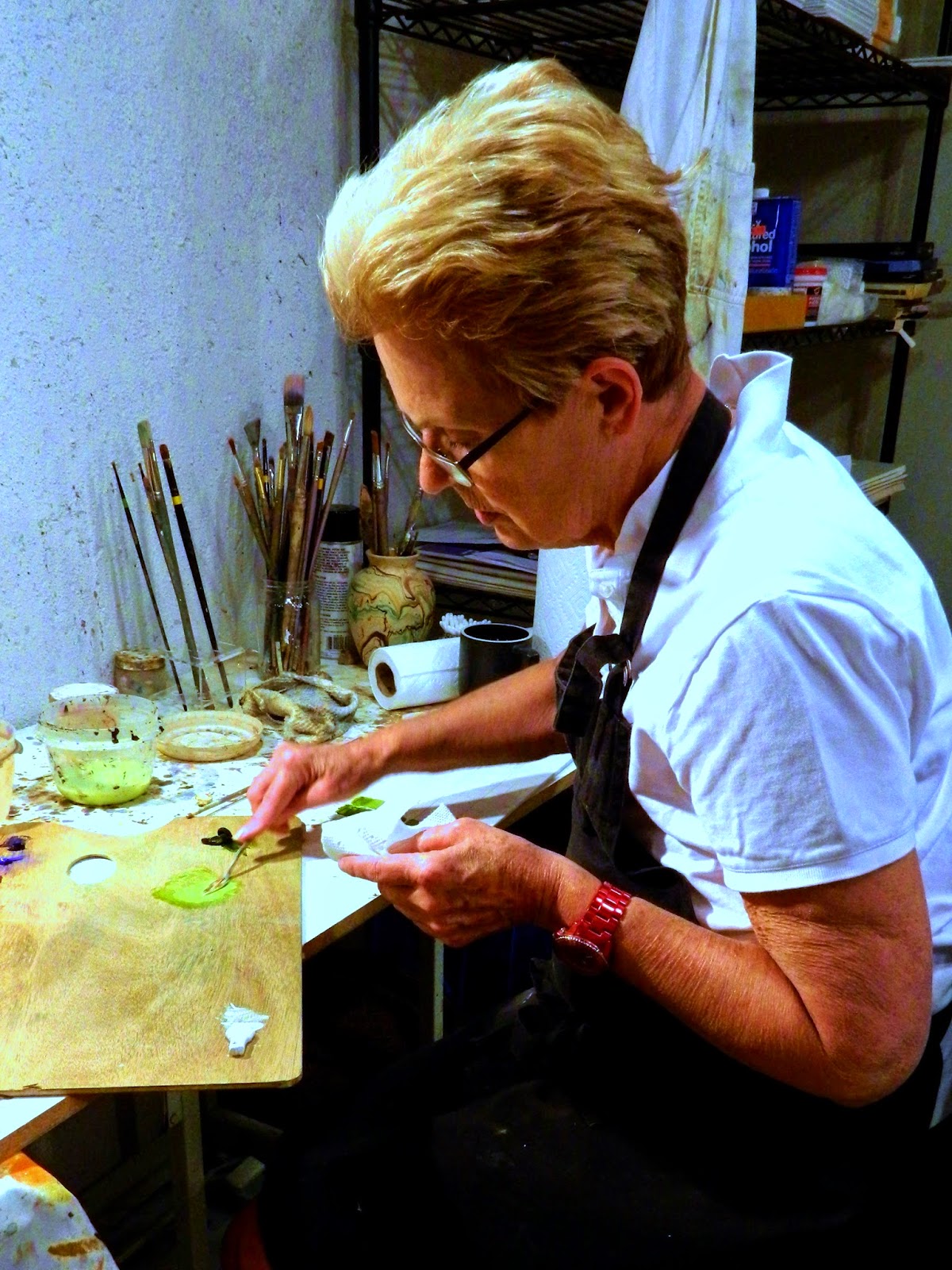 |
| Paint Table, oils, 5 x 7", palette knife drawing exercise #1 |
I needed another green on my palette. Viridian wasn't enough--too blue. I charted Sap Green and discovered it better suited my woodsy landscapes. Charting is tedious business. To relieve the tension, I started painting from life--my incredibly dull life as it was sitting at my disorderly paint table painting squares. My palette knife set sat near by all shiny and bright. What better time to try drawing with it as Schmid suggested? Learning it's capacity for line was my intent. Though awkward, this still life painted from life, not a reference photo as usual, came out surprisingly okay. Having no models walking about the house, woodsy landscapes and still lifes are my only choice for exercising and honing my drawing/painting skills--till Fall when the open studio session begin.
 |
Sap Green chart. Add another color to your palette, check it out by doing a chart. Doing this one,
made me realize I need both Viridian and Sap Green in my palette. It's not the best chart around. The near
whites aren't near white enough. The point is to recognize that. |
Making charts as well as painting pictures require regular brush and palette cleaning throughout the painting process.
Schmid cleans his palette every twenty minutes during a painting session. He cleans his brush after every stroke. YES, EVERY STROKE. Cleaning his brushes involves two canisters of mineral spirits. After applying a color, he cleanses the brush in one container, wipes it relatively clean, then cleanses it in the other container and wipes it cleaner. Lot's of rags or high end paper toweling is used.
.JPG) |
My new palette knives, shiny and bright with flat handles. They do not roll over
when set down like the old encrusted ones on the right.
|
.JPG) |
Totally concentrating
upon mixing color |
At the end of the painting session, Schmid "shampoos" each brush with a bar of gentle skin cleansing soap till the bar is clear of color. Then he shapes the bristles and paper clips the flat brushes between two pieces of heavy-duty paper--he didn't say what kind, but I think index card stock would do. In three days, when all the pigment has settled to the bottom of the mineral spirit container, he pours off the clear fluid to be reused later.
As for the sludge, I don't recall that he mentioned how he disposed of it.
I've decided to wipe it out and throw the paper toweling into a tightly closed receptacle to be thrown away. Washing it down the drain just seems irresponsible. We do not want poisoness paint pigments going back into our water supply.

.JPG)
.JPG)


Sap green is my favorite green... =)
ReplyDeleteMine too. I was surprised that the only green on Schmid's Flemish palette was Viridian. Of all the greens that one is farthest removed from the greens you see in the woods. Mixed together, however, you get a balanced green--not too yellow, not too blue.--not that I need a balanced green that often, if at all. :-))
DeleteThe 'still' life is hardly that, and at first glance, Way too busy to make sense Of! But you Can! Brilliant exercise.
ReplyDeletePerhaps it's busy because I was? Art is expressionistic. Our selection of what we paint mirrors how we feel,I think. :-))
DeleteHey Linda,
ReplyDeleteAnother fascinating look into the life of a working (and learning) artist. I really like the still life, Linda. Just enough definition to let viewers know what they're looking at, without needless detail. If you hadn't told me, I would never have guessed it was only 5x7! And good luck with sludge disposal. There seems to be almost no easy and ecologically-friendly way--especially living where you do. I wonder if you would be attacked by purists for driving a nasty polluting car to take a tiny amount of paint sludge to an approved disposal site? It seems there's no way to win. Anyway...
Enjoy your weekend.
Sincerely,
Gary.
OMG! The sludge police! I forgot about them. I don't suppose me having only 1500 miles on my car purchased last December would save me?
DeleteLove the still life. It has a wonderfully natural appearance and my eye moves in and out enjoying the exploration.
ReplyDeleteSap green. Egh! Make sure it is permanent. I bought a painting from a good gallery and after a couple of years I noticed the main tree was not quite as beautiful. It was turning brown, in fact quite an ugly brown. Apparently the artist had used an under painting of umber. Turns out the artist had used Sap Green - a fugitive color, and the gallery had to ask them to repaint it. Now, thank heavens, they put out a Permanent Sap Green, same as with Alizarin. I am sure you bought the permanent Sap, but thought I would mention it just in case.
P.S. Does he (RS) mention in his book that he used Viridian with Transparent Rd Oxide to make the most wonderful rich, transparent green?
ReplyDeleteNo he didn't. He did, however, stress the importance of charting palette colors so you could discover for yourself the colors your colors could produce. Yesterday, the third book arrived, Alla Prima II Companion by Katie Swatland , his student. It discusses all of Svhmid's materials, tools and techniques. On page 2 of surfaces, all the acrylic canvas boards I bought last month for practice went wrong; he preferes a lead primed surface. Thanks for the heads up on the Sap Green. My tube does not say Permanent. I'll correct that. I also didn't know about Viridian. I just lucked out at the art supply store; permanent as all they had on the shelves.
DeleteLinda, you call this an exercise! I think it's a lovely work of art. It's the type of painting I would buy any day. No fuss, no muss. Perfect for me, everything's there, love it! :)
ReplyDeleteThanks Helen. It's an exercise in the fact that I used the smallest palette knife to make the initial drawing. When I saw I had actually made a comprehensible drawing, I used a brush to fill it out. I really did just do it to take a break from painting squares. The small canvas just happed to be laying on the paint table. The still life arrangement aren't as arrangement at all. It shows you exactly what was on my paint table at the time. What I don't care for in still life's is that the objects are arranged with the idea of painting a still life. I like happenstance. This is exactly that.
DeleteI left a sizeable comment on your blog recently that never appeared. I don't know what happened, but it was mainly to say that I admire your steadfastness in learning and growing. Depresses me that you might think that I have abandoned you. I have not abandoned you. Love what you do.
ReplyDeleteAnyway, I just love this picture. It is more than okay! And, btw, I went to Amazon and Barnes & Nobles or something or other, to look up Schmid's book - that is one darned expensive book! But more than worth it, I am sure.
That is some great palette knife set! I have a few, and use them now and again - not quite sure how to use them correctly. Love your charts!
I love Schmid's advise about cleaning brushes. He is definitely a more patient man than I. But I definitely have multiple jars of water (medium) going so that I do not make mud. And a long time ago when I actually dabbled in oils (and it will happen again believe you me!), I learned about a mild old fashioned soap called fels naptha, to clean the brushes. I have used the same bar since I picked up painting again, but now it is crumbled to about nothing, and I've been using hand soap. I need to see if they even sell it any more.
Did I say you abandoned me? I never would have said that. It's too self-centered. I probably said I missed you---anyway, thanks. I just told Helen that I like happenstance when it comes to drawing/painting from life. What could be more happenstance than how I set things down on my painting table?
DeleteSvhmid's books are very expensive. I invested in him because I admire his gestural style and have passed on taking oil painting classes at the art association for the same amount plus another hundred--too good ole boy over there. Buying his Alla Prima II and, just recently, the Alla Prima II Companion was my trade off. The Companion book costs the same as Alla Prima II. It's about his materials, tools and techniques. So far everything I've been using has been for amateurs--but then, that's exactly what I am at this stage in life. I might make some changes though. I do like to see how things work. If you too are moved to teach yourself, I do recommend both these books for about the same price as an art class. for figurative painting, I'm going to attend the open studios in the Fall for just $13 a session. There's no instruction, just a live model. We have both done enough painting to know that painting daily--or practice, practice, practice--is how you get where you want to go.
There is wonderful geometry in your from-life painting..the charts, the tubes, the easel and brushes..it is all a nice "foil" for the splashes of color. You've got be convinced to buy the new Schmid book... I have the old one (which is great) but I've heard that his new book has a ton of "new" information in it. I have seen him demo that paper business with his brush in a dvd.
ReplyDeleteThen there's the Alla Prima II Companion by Katie's Swatland, RS's assistant. I just started reading that this morning. It covers his materials, tools and methods. Just on page 35, all I've gotten out of it is a lot of questions with regards to how long do I want my paintings to last in excellent condition? You'll read why in my next post--maybe?
DeleteThe little still life definitely made painting color squares more interesting. The angular dark line is the electrical cord of a lamp. It actually curves, but the palette knife was uncooperative in my hand. :-))
It is incredible that this energetic piece is so tiny! I wonder if you might consider dong something like this a bit larger? I saw some of Richard Schmids' work up close and personal this week at the Coeur d'Alene Auction where his pieces generated some spirited bidding and nice prices! I thought of you as I looked closely at his brush work and crisp clear color.
ReplyDeleteThanks. Tiny is very unusual for me. But the little canvas was leaning against the pole of the lamp, I needed a break and there was a full palette and a knife sitting right there. I figured still life/palette knife drawing practice. I did use a brush to add most of the high colors. The subject, the set up of objects, wasn't a set up at all. You see what was. I don't like set up still life's. They strike me as phony. Drawing happenstance from life does appeal to me.
DeleteLove the photo of you concentrating, Linda!
ReplyDeleteThose shades of greens are so pretty together… especially the brownish greens.
Aren't they! These are the colors of safaris--and my favorite cargo shorts. Thanks A.
DeleteI just love this painting you've done Linda! You are so skilled at composition and color. It shows in everything you do.
ReplyDeleteSchmid's book has obviously inspired you.
It strikes me that YOU could easily write a book. You have a lifetime of knowledge and skill that translates into your every visual creation.
You are a master artist. Thank you for sharing and encouraging and being an all around phenomenal human being.
WOW! You bowl me over with your accolades. Come by any time. I need you in my life! --I've told you many times what I think of your dazzling work. I showed Ellis your latest toon with the clown and he was dazzled too. I am so glad you are back to doing what you do best. I think we share similar apprehensions about our own abilities. I think it's a female malady that has to be stamped out of the women to be. We'd have a lot to talk about if we ever got together--AND YOU RIDE A MOTORCYCLE TOO!
DeleteThank you Linda. I agree about it being a female malady and I agree... let's stamp out that demeaning self doubt. We are powerful women who know what we want and by damn... we do it!
DeleteI'd be pleased to get together with you too. We'd kick ass then take names.
I meant every word of my accolades. You are one hell of an artist.